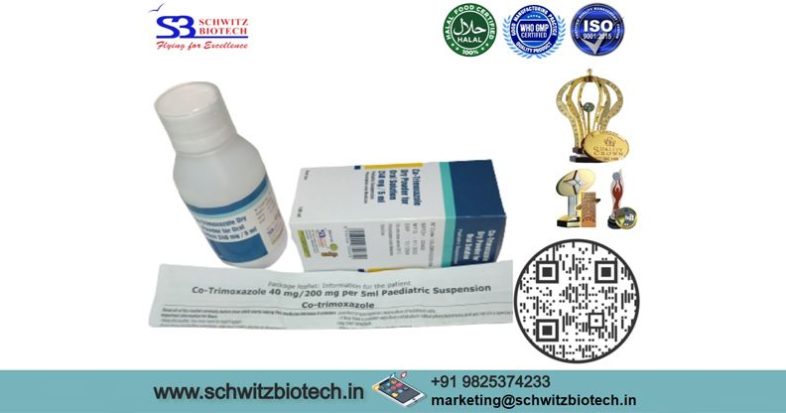CO-TRIMOXAZOLE

BECLOMETHASONE DIPROPIONATE 0.025% + CLOTRIMAZOLE 1% + NEOMYCIN SULPHATE 0.5% CREAM
CO-TRIMOXAZOLE TABLETS BP 960 MG
Read all of this leaflet carefully before you start taking this medicine because it contains important information for you.
Read all of this leaflet carefully before you start taking this medicine because it contains important information for you.
- Keep this leaflet. You may need to read it again.
- If you have any further questions, ask your doctor or pharmacist.
- This medicine has been prescribed for you only. Do not pass it on to others. It may harm them, even if their signs of illness are the same as yours.
- If you get any side effects, talk to your doctor or pharmacist. This includes any possible side effects not listed in this leaflet. See section 4.
WHAT CO-TRIMOXAZOLE TABLETS ARE AND WHAT THEY ARE USED FOR CO-TRIMOXAZOLE
- 80mg/400mg Tablets (called ‘Co-trimoxazole tablets’ in this leaflet) are made up of two different medicines called sulfamethoxazole and trimethoprim.
- Both belong to a group of medicines called antibiotics. They are used to treat infections caused by bacteria. Like all antibiotics, Co-trimoxazole only works against some types of bacteria.
- This means that it is only suitable for treating some types of infections. Co-trimoxazole tablets are used for adults and children over 12 years.
CO-TRIMOXAZOLE TABLETS CAN BE USED TO TREAT OR PREVENT:
- lung infections (pneumonia or PCP) caused by a bacteria called Pneumocystis jiroveci infections caused by a bacteria called Toxoplasma (toxoplasmosis).
- Co-trimoxazole tablets can be used to treat:
- bladder or urinary tract infections (water infections)
- lung infections such as bronchitis
- ear infections such as otitis media
- an infection called nocardiosis, which can affect the lungs, skin and brain.
WHAT YOU NEED TO KNOW BEFORE YOU TAKE CO-TRIMOXAZOLE TABLETS
- you are allergic to sulfamethoxazole, trimethoprim or Co-trimoxazole or any of the other ingredients of this medicine (listed in section 6)
- you are allergic to sulfonamide medicines. Examples include sulfonylureas (such as gliclazide and glibenclamide) or thiazide diuretics (such as bendroflumethiazide – a water tablet)
- you have liver or kidney problems
- you have ever had a problem with your blood causing bruises or bleeding (thrombocytopenia)
- you have been told that you have a rare blood problem called porphyria, which can affect your skin or nervous system
- Co-trimoxazole should not be given to infants during the first 6 weeks of life. If you are not sure if any of the above apply to you, talk to your doctor or pharmacist before taking Co-trimoxazole tablets. Warnings and precautions Talk to your doctor or pharmacist before taking Co-trimoxazole if you:
- have severe allergies or asthma
- have been told that you have a rare blood problem called porphyria, which can affect your skin or nervous system
- don’t have enough folic acid (a vitamin) in your body – which can make your skin pale and make you feel tired, weak and breathless. This is known as anaemia
- have ever had jaundice which can cause yellowing of your skin or the whites of your eyes
- have a problem with your metabolism called phenylketonuria and are not on a special diet to help your condition
- are elderly
HOW TO TAKE CO-TRIMOXAZOLE TABLETS
- Always take this medicine exactly as your doctor or pharmacist has told you. Check with your doctor or pharmacist if you are not sure.
- The recommended dose is
- Adults (>18 years old):2 Tablets every 12 hours
- Children over 12 years
- The schedules for children are according to the child’s age and body weight provided in the table below:>12 years and over OR >Weighing 53kg or above : Two tablets in a morning and two tablets in an evening.
- Co-trimoxazole should be taken for at least five days.
- Make sure that you finish the course of Co-trimoxazole which your doctor has prescribed. Co-trimoxazole 80mg/400mg tablets are not usually given to children under 12 years old.
- If they have been given to your child under 12 years, please speak to your doctor or pharmacist for more information.
- If you take more Co-trimoxazole tablets than you should
- Take the medicine pack with you. If you have taken too many Co-trimoxazole tablets you may:
- feel or be sick
- feel dizzy or confused.
POSSIBLE SIDE EFFECTS
- Like all medicines, this medicine can cause side effects, although not everybody gets them. Stop taking Co - trimoxazole tablets and tell your doctor immediately if you have an allergic reaction.
- Signs of an allergic reaction include:
- Very rare (may affect up to 1 in 10,000 people):
- Sudden wheeziness or difficulty breathing
- Fainting
- Swelling of face
- Swelling of mouth, tongue or throat which may be red and painful and/or cause difficulty in swallowing
- Chest pain
- Red patches on the skin.
- Stop taking Co-trimoxazole tablets and tell your doctor immediately if you develop the following symptoms: Very rare (may affect up to 1 in 10,000 people):
- A widespread rash with blisters and peeling skin, particularly around the mouth, nose, eyes and genitals (Stevens-Johnson syndrome) or on much of the body surface (toxic epidermal necrolysis) (see section 2 ‘Warnings and Precautions’)
- A red, scaly widespread rash with bumps under the skin and blisters accompanied by fever at the initiation of treatment (acute generalised exanthematouspustulosis (AGEP)) (see section 2)
- Mouth ulcers, cold sores and ulcers or soreness of your tongue
- Skin lumps or hives (raised, red or white, itchy patches of skin)
- Jaundice (the skin and the whites of your eyes turn yellow). This can occur at the same time as unexpected bleeding or bruising
- Very Common (may affect more than 1 in 10 people):
- Excessive potassium in the blood (may occur as muscle cramps or pain, irregular heartbeats, unusual tiredness or weakness).
- Common (may affect up to 1 in 10 people):
- An infection called thrush or candidiasis which can affect your mouth or vagina.
- It is caused by a fungus
- Headache
- Feeling sick (nausea)
- Diarrhoea
- Skin rashes
HOW TO STORE CO-TRIMOXAZOLE TABLETS
- Keep this medicine out of the sight and reach of children.
- Store below 25ºC in a dry place and protect from light.
- Do not take this medicine after the expiry date which is stated on the label/carton/ bottle.
- The expiry date refers to the last day of that month.

